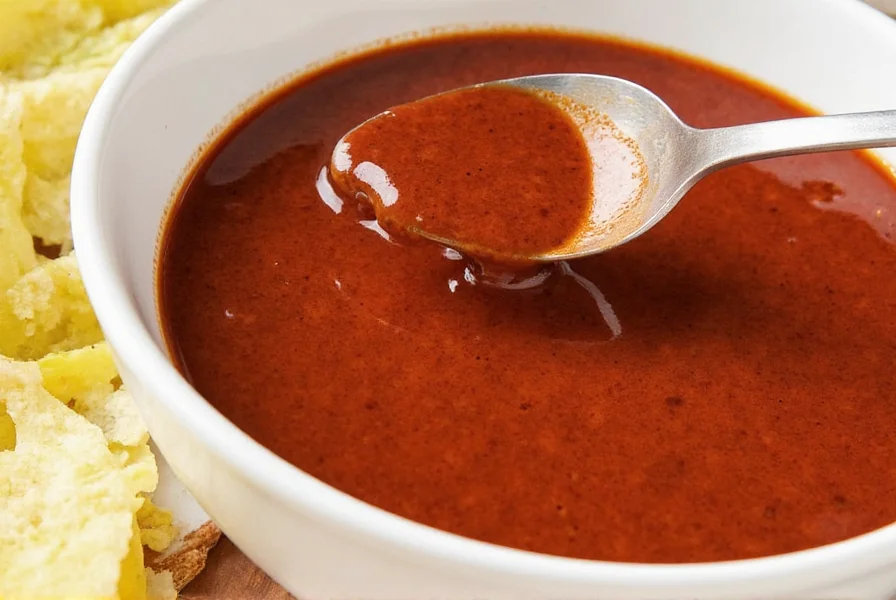Adobo sauce is a rich, tangy, tomato-based condiment made with vinegar, garlic, paprika, and spices, commonly used as a marinade and flavor enhancer in Latin American and Filipino cuisines. Unlike adobo seasoning (a dry spice blend), adobo sauce contains liquid ingredients and often includes chipotle peppers. This comprehensive guide explains exactly what adobo sauce is, how it differs from similar products, the best brands to buy, and how to use it in everyday cooking.

Table of Contents
- What Is Adobo Sauce? (The Clear Definition)
- Adobo Sauce vs Adobo Seasoning: Key Differences
- What's Really in Adobo Sauce?
- Adobo Sauce Around the World
- Best Adobo Sauce Brands: 2025 Buying Guide
- How to Use Adobo Sauce: 7 Practical Applications
- 5 Simple Adobo Sauce Recipes for Beginners
- Frequently Asked Questions About Adobo Sauce
What Is Adobo Sauce? (The Clear Definition)
Adobo sauce is a thick, reddish-brown, tomato-based sauce that typically contains vinegar, garlic, paprika, oregano, cumin, and salt. Unlike dry adobo seasoning, adobo sauce has a liquid consistency and often includes chipotle peppers (smoked jalapeños) which give it a distinctive smoky flavor. The name comes from the Spanish word adobar, meaning "to marinate" or "to pickle," reflecting its original purpose as a preservation method in Latin American and Caribbean cooking.

Adobo Sauce vs Adobo Seasoning: Key Differences
One of the most common confusions is between adobo sauce and adobo seasoning. Understanding this difference is crucial for proper cooking:
| Feature | Adobo Sauce | Adobo Seasoning |
|---|---|---|
| Form | Liquid, tomato-based sauce | Dry spice blend (powder) |
| Base Ingredients | Vinegar, tomatoes, garlic, spices | Salt, garlic powder, oregano, cumin |
| Common Uses | Marinades, sauces, braising liquid | Dry rubs, seasoning before cooking |
| Heat Level | Often contains chipotle peppers (medium-hot) | Varies by brand (usually mild) |
| Substitution | Not a direct substitute for seasoning | Not a direct substitute for sauce |

What's Really in Adobo Sauce?
The core ingredients found in authentic adobo sauce include:- Tomato base (tomato paste or puree) - provides body and color
- Vinegar (typically white or apple cider) - adds tanginess and acts as a preservative
- Garlic - essential for savory depth
- Paprika (often smoked) - contributes warmth and color
- Oregano (usually Mexican oregano) - earthy herbal notes
- Chipotle peppers - smoked jalapeños that add smokiness and heat
- Onion powder - subtle sweetness
- Cumin - earthy depth (in some variations)
- Salt and black pepper - flavor enhancers
Adobo Sauce Around the World
While the base ingredients remain similar, regional variations exist:
| Region | Key Ingredients | Traditional Uses |
|---|---|---|
| Mexico | Vinegar, garlic, oregano, paprika, chipotle peppers | Marinade for meats (pollo adobo), base for moles |
| Philippines | Vinegar, soy sauce, garlic, peppercorns (not tomato-based) | Cooked directly with meat (adobo de pollo), not a separate sauce |
| United States | Bottled versions with varying spice levels and ingredients | Marinades, flavor booster in burgers, tacos, dips |
| Caribbean | Vinegar, garlic, citrus, annatto | Preservation technique for meats and fish |
Best Adobo Sauce Brands: 2025 Buying Guide
Not all adobo sauces deliver authentic flavor. Here's how to choose the best one for your needs:
| Brand | Flavor Profile | Heat Level | Best For | Price (per 8oz) |
|---|---|---|---|---|
| La Costena Chipotles en Adobo | Authentic, smoky, balanced acidity | Medium | Traditional Mexican recipes, authentic flavor | $2.50 |
| Herdez Adobo Sauce | Milder, less vinegar-forward | Mild | Beginners, subtle flavor enhancement | $2.20 |
| San Marcos Adobo | Spicier, more garlic-forward | Medium-Hot | Grilling, robust flavors | $2.75 |
| Trader Joe's Adobo Sauce | Smoky, slightly sweet | Mild-Medium | Everyday cooking, pantry staple | $3.25 |
What to Look For When Buying Adobo Sauce:
- Real chipotle peppers (not just flavoring) for authentic smokiness
- Natural ingredients without artificial preservatives or colorings
- Balanced acidity - vinegar should enhance, not overpower
- Thick consistency that clings to food rather than being watery
- Clear ingredient list showing specific spices rather than "natural flavors"

How to Use Adobo Sauce: 7 Practical Applications
Move beyond basic marinades with these chef-recommended uses:
- Instant Flavor Booster: Stir 1-2 tablespoons into soups, stews, or bean dishes for instant depth
- Marinade Base: Combine with olive oil for chicken, pork, or tofu (use 1/4 cup per pound of protein)
- Spicy Mayo: Mix equal parts with mayonnaise for sandwiches, burgers, or dipping sauce
- Taco Sauce: Thin with a bit of water or broth for perfect taco consistency
- Roasted Vegetables: Toss potatoes, sweet potatoes, or cauliflower with adobo before roasting
- Breakfast Boost: Add to scrambled eggs, breakfast potatoes, or hash browns
- DIY Hot Sauce: Blend with vinegar and water for a custom hot sauce with more complexity

5 Simple Adobo Sauce Recipes for Beginners
These easy recipes require minimal ingredients and deliver maximum flavor:
- 15-Minute Adobo Chicken: Brown boneless chicken thighs, add 1/2 cup adobo sauce and 1/4 cup water, simmer 10 minutes. Serve with rice and avocado.
- Adobo Black Bean Dip: Blend 1 can black beans, 2 tbsp adobo sauce, 1 garlic clove, and 2 tbsp olive oil. Perfect for chips or veggie sticks.
- Adobo Roasted Sweet Potatoes: Toss cubed sweet potatoes with 2 tbsp adobo sauce and 1 tbsp olive oil. Roast at 400°F for 25 minutes.
- Adobo Shrimp Tacos: Sauté shrimp with 3 tbsp adobo sauce for 5 minutes. Serve in warm tortillas with cabbage slaw and lime.
- Adobo Pasta Sauce: Simmer 1/2 cup adobo sauce with 1 cup tomato sauce for 5 minutes. Toss with cooked pasta and cheese.

Frequently Asked Questions About Adobo Sauce
What's the difference between adobo sauce and adobo seasoning?
Adobo sauce is a thick, tomato-based sauce with vinegar, garlic, and spices, often found with canned chipotle peppers. Adobo seasoning is a dry spice blend containing similar ingredients but in powdered form without the liquid base. While they share flavor profiles, they're used differently in cooking - the sauce adds moisture while the seasoning is a dry rub.
Is adobo sauce the same as chipotle in adobo?
Yes, "chipotle in adobo" refers to the product where smoked jalapeños (chipotles) are preserved in adobo sauce. The sauce itself is the flavorful liquid mixture that surrounds the chipotles. While you can use the sauce from canned chipotles as adobo sauce, not all adobo sauce products contain whole chipotles.
How long does adobo sauce last once opened?
When stored properly in an airtight container in the refrigerator, opened adobo sauce typically lasts 2-3 weeks. For longer storage, you can freeze it in ice cube trays and then transfer the frozen cubes to a freezer bag, where it will keep for up to 6 months. Always check for signs of spoilage like mold, off smells, or discoloration before using.
Can I make my own adobo sauce at home?
Absolutely! A simple homemade version combines 1 cup tomato paste, 1/4 cup apple cider vinegar, 2 minced garlic cloves, 1 teaspoon smoked paprika, 1 teaspoon dried oregano, 1/2 teaspoon ground cumin, 1/2 teaspoon salt, and 1/4 teaspoon black pepper. Simmer these ingredients with 1/2 cup water for 10-15 minutes until thickened. You can adjust spice levels to your preference.
What can I use as a substitute for adobo sauce?
If you don't have adobo sauce, try these substitutes: 1) Mix 1 tablespoon tomato paste with 1 teaspoon vinegar, 1 minced garlic clove, and 1/2 teaspoon smoked paprika; 2) Use chipotle peppers in adobo (just the sauce portion); 3) Combine barbecue sauce with a splash of vinegar and garlic powder; 4) Make a quick version with enchilada sauce plus extra garlic and cumin. None will be identical, but they'll provide similar flavor profiles.
Is adobo sauce spicy?
Traditional adobo sauce containing chipotle peppers has a medium level of heat (2-5 on a 10-point scale). The smokiness of chipotles often masks some of the heat. If you prefer mild flavor, look for chipotle-free adobo sauce or dilute regular adobo sauce with tomato sauce. For extra heat, add cayenne pepper or additional chipotles.











 浙公网安备
33010002000092号
浙公网安备
33010002000092号 浙B2-20120091-4
浙B2-20120091-4